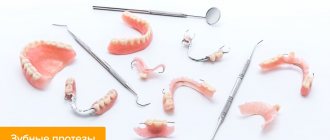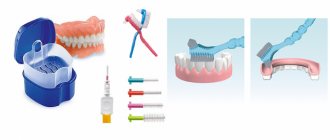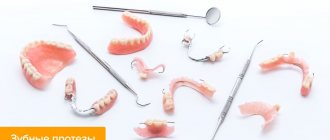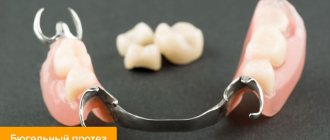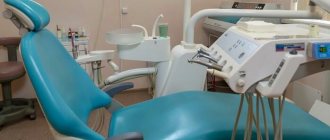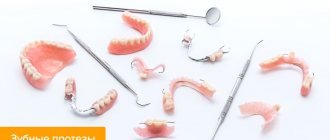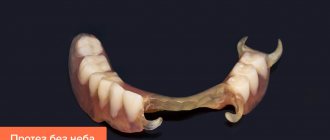From this article you will learn:
- what material are removable dentures made of?
- what types of dentures are there?
- What is the difference between dentures on implants and other removable dentures?
- conditionally removable dentures,
- how to choose the best modern and reliable prostheses,
- how to care for removable dentures,
- Prices for removable dentures in 2022.
About removable dentures
Removable dentures are a type of prosthetics that is carried out when teeth are partially or completely lost. Their feature is the ability to remove the denture (with the exception of some models). They are quite easy to care for. However, removable dentures require careful cleaning and oral hygiene. The advantages of this type of prosthetics:
- high aesthetic indicators;
- uniform load when chewing and, as a result, prevention of bone atrophy;
- individual production for each client;
- easy to care for;
- affordable price;
- quickly installed;
- short period of adaptation.
Today there are a large number of types of prostheses and materials from which these structures are made.
Indications for installation
Plastic dentures are necessary to replace all the teeth in the mouth or some of the lost elements.
Indications for installation:
- Complete absence of teeth. In this case, the structure will be attached to the gums due to the vacuum effect. This type of product is called removable suction cup jaws.
- Partial absence of elements. In this case, the devices are attached to the oral cavity using clasps. The structure is supported by its own preserved elements.
- Missing one unit in a row. In this case, dentists advise patients to have a butterfly denture. This system can be used as a temporary replacement for missing teeth until a permanent denture can be made.
Plastic structures are suitable for fixing mobile teeth, masking deformed elements and temporarily replacing missing segments in a row. There are few contraindications for installing plastic structures. The main ones are an allergy to acrylic, a short crown part of the tooth, and various malocclusions.
Varieties
If several teeth are missing from the dentition, a partial nylon denture can solve this problem. If only one tooth is missing, then the deficiency can well be compensated by a “single” prosthesis made of nylon, for the fixation of which you will not have to grind down the adjacent teeth, since the structure is fixed to them using clasps. “Butterfly” is a nylon prosthesis, which received such a poetic name due to the peculiarities of fixation to the supporting teeth, and is intended to replace one missing dental unit. Clasps really resemble butterfly wings.
In case of complete edentia, a complete removable nylon denture is used, and if previously it was not very popular due to the high softness of the material, now the popularity of such a product is only gaining momentum, and perhaps it will soon supplant its counterpart made of rough plastic. Although, some experts are not sure about this. It remains to add that the color of the material is selected individually.
Types of products
There are several types of systems depending on the production method, the materials used and the method of attachment in the oral cavity.
Structures are made in 2 ways:
- Compression pressing method. Such a product may not be ideally suited to the parameters of the jaw. However, in this case, getting a removable denture is the easiest and fastest way. Disadvantage of the system: long adaptation period, fragility.
- Casting method. With the help of casting, structures that most precisely match the parameters of the jaw are obtained. They imitate the patient’s teeth and gums as accurately as possible.
Based on the method of fastening, plastic products are divided into removable and non-removable. The first type is recommended for complete absence of teeth. Acrylic is usually used to produce a removable jaw.
Partially removable dentures are recommended for patients to temporarily replace elements when installing dentures. Another indication for their installation is partial edentia. Dentists consider plastic structures as a temporary solution to the problem, since the materials used for their production are of low quality and have low performance properties. The procedure allows patients to maintain an attractive appearance until it becomes possible to undergo prosthetics.
Butterfly prosthesis
Dental plastic or acrylic is most often used in the production of dentures. However, other, more modern materials are also used:
- Ethacryl. It has better strength and performance characteristics compared to acrylic.
- Bicryl. It is resistant to mechanical stress. Does not crack or sag when consuming hard foods.
- Ftorax. It is a translucent material that is invisible in the mouth.
- Acree Free. Made from acrylic resins. It is hypoallergenic due to the absence of monomers in its composition.
Consequences of long-term wearing
Nylon prostheses tend to gradually deform during use. The fact is that the frame is not rigid, but flexible, and accordingly, it is not able to distribute the load evenly. It is noteworthy that the maximum pressure occurs on the most “active” part of the orthodontic structure. For this reason, a person may experience discomfort while eating, and bone tissue atrophies faster. But that’s not all: the chewing load falls not only on the middle part of the gum, but also on the marginal part. This can negatively affect periodontal tissue. If the patient is not afraid of the possible consequences of wearing such structures, then he can safely contact the specialists of the A-Medic clinic.
Prosthesis manufacturing technology
Before installing the prosthesis, the doctor examines the patient’s oral cavity and identifies any contraindications to the procedure. After this, the person is sent for an x-ray to identify the location of the roots of the remaining teeth. Those elements that cannot be restored using conservative techniques must be removed.
Prosthetics are not performed even if there are tumor-like formations in the soft tissues of the mouth. Procedures are prescribed only after removal of the seal (alveolectomy).
The production of a removable denture from acrylic plastic occurs in several stages:
- Grinding of supporting teeth. The procedure helps prevent negative consequences associated with contact between enamel and plastic. The duration of the work ranges from 40 minutes to 3 hours, depending on the specifics of the procedure.
- The dentist takes an impression of the patient’s teeth and sends it to the laboratory for further fabrication of structures. The height of the bite is determined using wax rollers for 15-20 minutes.
- In the laboratory, a wax model of future dentures with artificial teeth implanted into it is recreated.
- After making the model, the orthopedist tries it on the patient's jaw.
- At the last stage, a plastic denture is made. After installation in the oral cavity, the structure is polished and ground. The color of the enamel is selected by the doctor during the clinical stages of treatment.
The injection molding method and pressing have similarities in preparatory activities. In each case, a preliminary formation of a three-dimensional model of the patient’s oral cavity occurs.
For better fixation of the product in the oral cavity, patients are recommended to use special glue. The substances are used once a day: they are applied in a thin layer to the surface of the material in those places where it comes into contact with the gums. At night, the product is removed, and the remaining adhesive is removed.
The choice of a suitable composition is important for reliable fixation of the structure. The degree of patient comfort when wearing a prosthesis depends on the correct decision. Before giving preference to one or another product, you need to pay attention to the following nuances:
- The glue must retain its effect for at least 12 hours. Otherwise, the application procedure will have to be repeated several times a day.
- The paste should be of medium consistency. Liquid glue will spread over the denture, and solid glue will be noticeable in the oral cavity when you smile.
- Preference is given only to pharmaceutical products. Adhesive obtained from hand can cause swelling and redness of the soft tissues of the mouth.
List of popular denture creams:
- Protefix;
- Lakalut;
- Corega.
Popular adhesive for dentures
Advantages
- Orthodontic structures made of nylon break very rarely, which cannot be said about their acrylic counterparts, in which fracture of the bases is the main problem, occurring in 80% of cases.
- Hypoallergenic. Such products cannot cause an allergic reaction. And this is easy to prove with a simple example: after polymerization of acrylic, its composition contains up to 10% of the liquid (monomer) used to carry out this process. This substance is a strong allergen, and it can be released for five years from the date of installation of the structure. Nylon dentures do not contain monomer.
- Installation of the product does not imply grinding of the supporting teeth, that is, they are not required to be prepared.
- The absence of metal elements is a significant advantage, because they are too noticeable when talking and smiling. The nylon orthodontic structure is completely indistinguishable from real teeth.
- If the product is made correctly, it will not rub the gums and will not cause discomfort.
- Nylon has a uniform structure, which is explained by the peculiarities of its production, which means that a product made from it will fit as tightly as possible to the gum.
- Inability to color and absorb moisture are very important characteristics of the material.
- Such structures do not tend to loosen the supporting teeth, which is very important if they are affected by periodontitis. It is noteworthy that it is possible to get dentures in this way even if you have some dental diseases, and this method even allows you to strengthen your dentition, which greatly contributes to a speedy recovery.
- Reliable fixation without glue, gel and crowns, which is the merit of clasps.
- A nylon prosthesis, the price of which is affordable for almost everyone, is designed for 5-7 years of intensive use. But only if you follow all the care recommendations that a specialist from the A-Medic clinic will certainly give.
Opinions are divided!
Some patients are completely satisfied with orthodontic structures made of nylon, while others, on the contrary, tend to abandon them and give preference to acrylic analogues. Why is that? Because the Earth is full of rumors, and reviews read on the Internet and the opinions of friends who have had negative experiences wearing nylon prostheses can play a cruel joke on the patient. Where did this stereotype come from? The fact is that the first nylon structures were very soft and elastic, and at first foreign dentists used them only for temporary prosthetics, since the cost of nylon dentures was very affordable.
Their appearance in Russia greatly delighted less than honest dentists, who began recommending to their patients the installation of just such dentures, rather than acrylic ones. This “aggressive marketing” did not benefit ordinary people, since the structures lasted no more than three years, and doctors claimed that they were designed for a longer operational period.
In addition, the surface of the material, due to its softness, was poorly polished, and the orthodontic product itself was not the height of perfection and caused a lot of inconvenience when worn for a long time. All this became the reason for the emergence of stereotypes, which are helped to be broken by fundamentally new designs made from more modern and “adapted” varieties of nylon. By the way, a specialist at the A-Medic clinic can select the most suitable material for the patient.
Pros and cons of dentures
Among the positive characteristics of plastic dentures, the following should be noted:
- accessibility to wide sections of the population;
- colorlessness, making dentures similar to natural teeth;
- invisibility of the product while smiling;
- speed of production in contrast to metal-ceramics;
- Possibility of installation in 1 visit to the dentist;
- the ability to select a design of any color, shape and size.
Which dentures are best for teeth?
Like other dental structures, plastic dentures have their disadvantages:
- short service life (less than 5 years);
- the likelihood of developing allergic reactions to acrylic;
- the appearance of bad breath due to insufficient care of the structure;
- the possibility of damage to the soft tissues of the mouth due to the large area of contact of the prosthesis with the palate;
- loss of taste of consumed products due to the product blocking taste buds;
- inability to chew hard foods;
- the need for constant visits to the doctor to assess the condition of the prosthesis.
Due to the porous structure, the color of the prosthesis may change, so when wearing it, it is better to avoid coloring products (juices, soda, coffee, tea), so that the material retains its appearance for as long as possible, it is necessary to give preference to high-quality metal-plastic.
Interesting facts about dental nylon
Nylon is a thermoplastic that scientists have been studying for almost 70 years. As you know, nylon is a type of plastic that becomes highly elastic when exposed to a certain temperature. This property makes it possible to artificially recreate human organs and tissues, and research in this area is still ongoing. Over time, nylon was recognized as a safe material for the human body. And therefore it began to be actively used not only in dentistry, but also in medicine.
Americans were the first to “try on” nylon dentures. There is even a version that such orthodontic structures were created specifically for people in “extreme” professions (rescuers, police, military, firefighters, stuntmen). The professional activity of these people is associated with constant risk, and therefore dentures for them must be made of elastic materials, and nylon is most suitable for these purposes. Orthodontic products made from it are durable and not so easy to break. In Russia, prosthetics with nylon prostheses is just gaining momentum, and this know-how appeared back in 2001.
It is worth noting that both materials and technologies are constantly being improved, and now there is an incredible number of varieties of nylon used in different areas of human activity. For example, dental technicians and dentists around the world are well aware of nylon called AcryFree, which successfully combines the positive characteristics of nylon and acrylic. It is this material that is more suitable for the manufacture of complete removable dentures, since this symbiosis is ideal in all respects.
Product care
To increase the life of artificial teeth, you need to follow certain rules for caring for them. It is important to clean the structure from food debris and plaque in a timely manner to prevent bad breath and the development of dental diseases. Patients wearing plastic prostheses must:
- Clean the product daily using a brush and paste;
- after eating, remove the device from the mouth and rinse under running water;
- do not remove the structure at night during adaptation;
- do not store artificial teeth without a special solution;
- For care, use special tablets and pastes.
Cleaning the prosthesis
Question-answer section
What is the maximum service life of dentures?
Experts say that the average service life of the device is 3 years, but with good care you can increase the service life to 5 years. If there is even the slightest damage to the plastic, you should immediately contact the clinic for restoration work.
Removable teeth are also sent for repair if the functionality of the locks is impaired or the initial shape of the arch changes. The price for repairing the product depends on the complexity of the dental work and the size of the structure.
Why does plastic turn dark?
The problem occurs due to the roughness of the material. The porous structure is maintained even after polishing and grinding the linings. Because of this, food and dye residues accumulate on the surface of the prosthesis. Structures lose their original appearance due to plaque.
How to whiten a denture?
The removable jaw is effectively cleaned using abrasive compounds. To do this, you can use special powders or regular baking soda. The procedure should not be repeated too often, as the abrasive components leave small scratches on the product. Because of this, even more plaque accumulates on their surface.
How to clean dentures?
Pharmacies sell many products designed for cleaning and whitening removable jaws. They are usually sold in tablet form to be dissolved in water. The product is immersed in a disinfectant liquid overnight. The most popular manufacturers of tablets for cleaning dentures: Dental, White, Corega, President. Such cleansing is carried out once every 7 days. The procedure gives the structures their original appearance and prevents the proliferation of pathogenic bacteria on their surface.
How is professional whitening of artificial teeth performed?
If home care methods for the device do not produce results, you should contact the clinic for a professional cleaning procedure. This service is provided by almost all dental institutions. In a clinical setting, the prosthesis is polished to reduce contamination later.
About the disadvantages
- Soft dentures are very easy to damage if you use regular pastes and brushes to clean them. In order for the care to be carried out correctly and not cause the product to fail and damage its appearance, you will need to take care of purchasing special liquids and brushes.
- If the material is too soft, this can lead to negative changes in bone tissue. That is, it simply atrophies, and unevenly. In addition, a loose fit of the clasps is the cause of excessive mobility of the structure, which can lead in mild cases to chafing of the mucous membrane, and in complex cases to periodontal disease.
- Dentures made of nylon, the prices of which vary, are not particularly amenable to repair and adjustment. In order to carry out the correction, the doctor requires a special “repair kit”.
- If the structure consists of nylon gums and plastic teeth, then the technician must correctly fix these two materials to each other. Otherwise, the teeth will simply come off, and at the most inopportune moment.
- Potential “carriers” of nylon dentures claim that orthodontic structures made of nylon tend to absorb odors, for example, tobacco or food.
- Pigmentation ability. One can argue with this, since much here depends on the quality of the material and its porosity. In general, staining a denture is not such a big problem, since it will still need to be professionally cleaned periodically.
- The appearance of scratches on the surface is a problem that arises due to the fault of a person who does not properly care for the product.
Patient reviews
Oksana, Tver. The doctor recommended prosthetics with plastic structures to me after I lost 1 tooth, visible when I smile. There was no money for implantation, so I was recommended an alternative way to restore a lost tooth - a butterfly denture. The cost of the design is only 15,000 rubles. The product is invisible when worn. At night, remove the structure and clean it with a brush and special paste. People around me don’t notice that one of my teeth is not real.
Kostya, Samara. Since I was young I have had problems with my teeth and regularly see the dentist. After the teeth began to loosen, the doctor suggested installing a self-adhesive plastic denture. At first it was unusual to talk and eat solid food, so I took all meals only in crushed form. I was able to return to my previous diet after 3 weeks.
Anton, Perm. After a maxillofacial injury, my 3 front teeth were removed. This situation caused my discomfort in front of others. After some hesitation I made a choice in favor of a plastic bridge. The product was manufactured in a short time, but after its installation I felt significant discomfort while talking and eating. Another unpleasant problem was that the prosthesis constantly rubbed the gums. I had to go back to the clinic to have the product corrected. It’s been 2 years now and now I wear the prosthesis regularly, taking it off only at night. I don’t feel the same discomfort from wearing it.
Material
For the manufacture of orthodontic structures, dental nylon is used, endowed with some useful properties.
For example, it is flexible and very similar in appearance to real fabrics. Sometimes flexible nylon dentures are called “invisible”, and this is true, because they literally merge with the mucous membrane and look very realistic. And from the outside it is not at all noticeable that a person’s teeth are not “his own”, but artificial. Dental nylon has such a property as softness. This material is pleasant to the touch, despite the fact that it is a type of plastic. Ordinary plastic, from which orthodontic structures were previously made (and are still made) has a number of serious disadvantages. For example, products made from it rub the gums and are highly hard, which means that when wearing a plastic prosthesis, a person experiences not the most pleasant sensations and even discomfort. It is noteworthy that flexible nylon dentures are fixed to the supporting teeth using soft clasps.

